May 2022
Pursuing New Aesthetics in Wajima Urushi Lacquerware
-
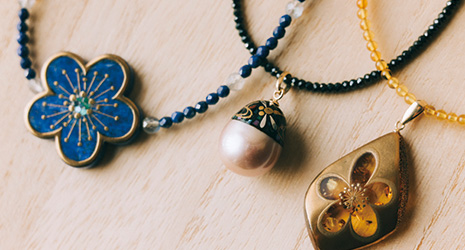
Jewelry combining maki-e and semiprecious stones. From the left, urushi combinations with lapis lazuli, Akoya pearl, and amber. 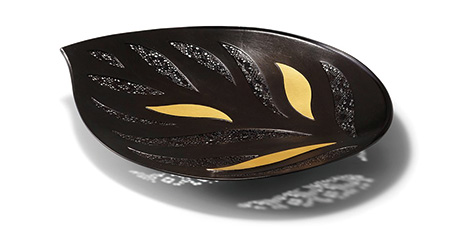
A plate in which a combination of lace, gold maki-e and lacquering creates wonderful nuances
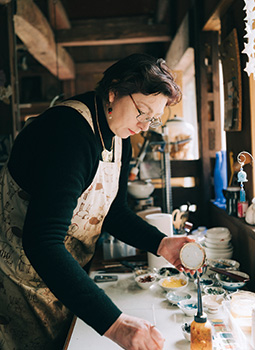
Suzanne Ross making a lacquer work 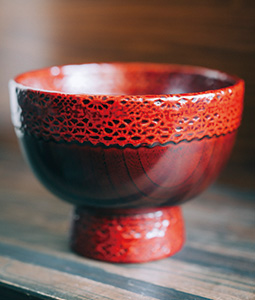
A lacquerware bowl using lace as reinforcement 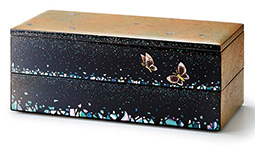
A box lacquered with maki-e and raden (mother-of-pearl inlay) quail’s egg shell inlay and silver maki-e 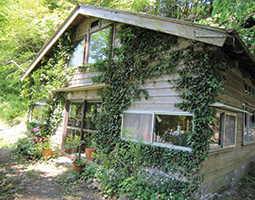
Ross’s studio, located in a beautiful natural environment 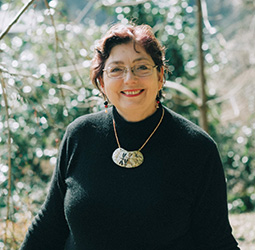
Ross wearing a lacquered accessory that she made herself

Suzanne Ross from the United Kingdom continuously creates numerous works as an urushi lacquer artist from her home in Wajima City, Ishikawa Prefecture, one of Japan’s premier producers of lacquerware.

Ross Studios Gallery in Wajima City, Ishikawa Prefecture by the Sea of Japan is full of a diverse range of urushi (lacquer) works, including easily handled vessels with simple and warm texture, glossy accessories that combine pearls and precious stones with urushi, and bold paintings that bring together washi and urushi. These were all made by Suzanne Ross from London, England. Ross moved to Wajima City in 1990 and has come to create all kinds of original lacquer works based on the traditional techniques of Wajima-nuri but with her own unique sensitivity and innovative ideas.

Ross first encountered Japanese lacquerware as a student at a London art school. She recalls, “There was an exhibition about Japanese traditional crafts at the Royal Academy of Arts* and I was so taken with a piece of lacquerware I saw there. I felt it was so beautiful with the gold and shell fragments glittering in the deep dark lacquer.” That piece was a suzuri-bako inkstone box by the Japanese painter and craftsman Ogata Korin** (1658–1716). The experience motivated her to try to make her own lacquerware and she decided to go to Japan.

When Ross first came to Japan in 1984, she met a teacher teaching ink painting and calligraphy in English in Tokyo, and this allowed her to learn about Japanese aesthetics. Ross explains that “Japanese painting seeks meaning also in the empty spaces where nothing is drawn. Subjects are sometimes not painted completely on the paper. For example, you intentionally might draw the branches of a tree only partly on a screen. Doing this makes the people seeing it imagine what comes after that. I was influenced by this uniquely Japanese aesthetic.” Subsequently, she moved to Wajima and enrolled at the Ishikawa Prefectural Wajima Institute of Lacquer Arts in 1990.

The Wajima Institute of Lacquer Arts is a school whose purpose is to transmit the techniques of holders of Important Intangible Cultural Property, known as Living National Treasures, to the next generation. There, Ross studied traditional Wajima techniques as well as techniques for applying maki-e and raden (see here). Ross says that she has also challenged herself to broaden the possibilities of lacquer, for example by using French lace instead of linen to reinforce bowls.

Since she became an independent lacquer artist in 2000, Ross has organized several solo exhibitions, displayed works at traditional craft exhibitions, and actively worked to present her works. She has also been awarded several prizes, such as being selected for the Ishikawa Modern Art Exhibition.
In particular, her numerous pieces of lacquerware using lace as the base, which are one of her lifeworks, have earned praise both in Japan and internationally. She has broadened the scope of lacquer art through this completely new expression of lacquerware, where the lacquering gives the lace an unprecedented glossy surface and texture. The jewelry Ross makes by combining maki-e and semiprecious stones is popular among young Japanese and foreigners who are not familiar with lacquer art. Moreover, she has been continuously and vigorously engaged in activities to communicate the appeal of lacquer both in Japan and abroad, for example by giving lectures and holding workshops to introduce Japanese urushi in London, Hawaii, New York, and elsewhere.
At present, Ross’s studio is located some way up the mountains from urban Wajima. She took over a more or less dilapidated old-style cattle barn, turning it into a studio together with her husband.

Calling it “a place like heaven where you hear the murmuring of the river, that is close to the Sea of Japan, and where you are surrounded by a myriad plants, animals and insects,” Ross comments that “The nature here is truly beautiful. I take walks in the mountains and on the shore every day, getting inspiration from that nature. I want to spend the rest of my life using the time given to me to focus on making my works.”
This year, 2022, Ross will be taking on a big project that she hasn’t tried before, namely applying maki-e to musical instruments at the request of New York musicians. Ross’s adventures and challenges with lacquer are far from over.
* Combined art school and art museum
** One of the most prominent painters and craftsmen of the early-modern period in Japan. A representative work is “Red and White Plum Blossoms” (National Treasure).

